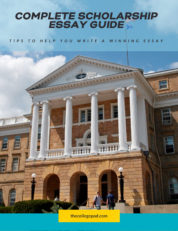The push towards free community college is intensifying around the country. In several states, including Texas, students can now complete two years of college without paying any tuition. Zilch. Nada.
This program is often referred to as last-dollar scholarship or promise program.
Last-dollar scholarships are a great deal. They are primarily reserved for low-income students and cover the tuition not covered by state and federal grants. While a two-year college is not ideal for everyone, many students who are highly motivated can start out there and successfully transfer to a four-year university.
Yes, there are grants and scholarships available at four-year universities for low-income students. However, in many cases, the grants and scholarships only cover tuition, which means the student is still on the hook for room and board. Room and board can easily cost around $10,000 annually.
Moreover, free community college is more than about the money. The last-dollar scholarship programs often include mentors. Mentors are critical to the success of first-generation and low-income students enrolled in college. A mentor can guide, support and motivate the student to enroll in college and persist to graduation. They can also serve as part of the student’s professional network after college.
What is a last dollar scholarship?
Last-dollar scholarships were established to allow more low-income students to access a college education. It allows students with financial need to attend at least the first two years of college without racking up student debt. The scholarship covers the tuition that is not covered by state and federal grants.
Although free college programs currently exist in sixteen states, not everyone is eligible.
To participate in this program, a student must attend a participating high school and meet certain income requirements. Students are able to pursue a degree, certificate or other workforce training tuition-free.
The programs are generally available at the community college level. However, in the case of Dallas County Promise, Promise Scholars (as students in the program are called) can also start out at a four-year partner college.
3 Free College Programs in Texas
Here are three programs in Texas that offer free community college:
1. Dallas County Promise (Dallas)
In 2017, the Dallas County Promise last-dollar scholarship program was launched. It is now available to students from 57 participating Dallas County schools. Each student is assigned a Success Coach (mentor).
Promise Scholars can enroll in or transfer to one of seven participating colleges. Those colleges are Dallas College, University of North Texas at Dallas, Midwestern State University, Texas A&M University Commerce, Texas A&M University Texarkana, Texas Woman’s University and Southern Methodist University.
>>RELATED: COLLEGE ADMISSIONS GUIDE
To be eligible for the Dallas County Promise program, you must attend a participating high school and meet Texas residency requirements. Students who received their GED in Texas are also eligible to participate.
To apply, you must first take the Dallas County Promise pledge which is available around February each year. Next, you have to apply to a partner college and submit the FAFSA or TASFA. Finally, you have to enroll at the college and voila, your scholarship is activated.
Students who graduate high school with an Associate Degree can participate in the program at the four-year college partners.
2. Lone Star College-Promise Scholarship (Houston)
Another free community college option is available through the Lone Star College system in Houston. This last-dollar scholarship program is open to high school graduates from participating high schools who plan to attend the Lone Star College.
The Lone Star College-Promise scholarship only covers tuition and mandatory fees and does not cover books or study abroad.
To apply, you have to be a graduate of a participating public or private high school, home school program or GED program. There are a number of other eligibility requirements. Students must enroll in college full-time (12 or more credits) in the Spring and Fall Semester.
Additionally, students must complete a community service component while in the program.
To participate, you should visit the Lone Star College-Promise website.
>>RELATED POST: HOW TO AVOID GRADUATING WITH MASSIVE STUDENT DEBT
3. AlamoPROMISE (San Antonio)
San Antonio’s Alamo College District recently launched its last dollar Promise scholarship program. The AlamoPROMISE is open to all eligible high school graduates in the San Antonio area.
To be eligible for the program, students must attend and graduate from one of 25 participating high schools.
To participate, you must first submit a “Save Your Seat” form, the FAFSA or TASFA and apply to one of San Antonio’s Alamo’s district colleges. Some students are required to attend a Summer Bridge program.
Summary
Free community college is a trend that is catching on, thanks to the last-dollar scholarship programs. It's a great way to start out your college career without amassing student debt, plus some programs provide added support. If you are not lucky enough to be living in one of the Texas cities mentioned above, check with your high school counselor or local community college to see if they offer a last-dollar scholarship program.



